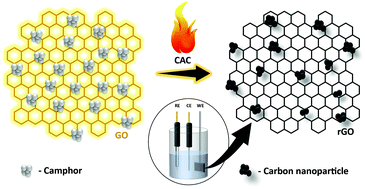Electrochemical properties of reduced graphene oxide derived through camphor assisted combustion of graphite oxide
Abstract
A facile method was demonstrated for the one-step synthesis of reduced graphene oxide (rGO) from graphite oxide (GO) using a camphor assisted combustion (CAC) process. Analysis of samples was carried out using FT-IR, XRD, TGA, Raman, BET, SEM and TEM techniques. The electrochemical properties of the rGO samples derived through the CAC process were determined using cyclic voltammetry, galvanostatic charge/discharge and impedance spectroscopy. It has been observed that the specific surface area and porosity of the rGO samples decrease with the increasing concentration of camphor during the CAC synthesis process. Thus, different mass ratios of GO and camphor such as 1 : 12, 1 : 16, and 1 : 20 in the CAC process yield rGO samples having surface areas (SBET) of 313.3, 297.5 and 177.4 m2 g−1. The pore volumes of the respective samples are 0.44, 0.45 and 0.23 cm3 g−1, respectively. The rGO derived using the 1 : 12 mass ratio of GO and camphor (rGO–12C) exhibits a high specific capacitance of 241 F g−1, which is significantly higher than that observed for chemically reduced graphene oxide (rGO-CR), which exhibits a specific capacitance value of only 153 F g−1. The capacitance retention of rGO–12C was found to be 98% even after 1000 galvanostatic charge–discharge (GCD) cycles, suggesting its potential applications in electrochemical energy storage.



 Please wait while we load your content...
Please wait while we load your content...